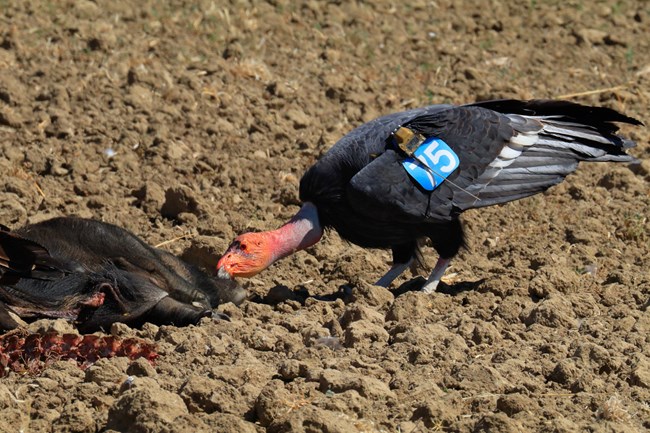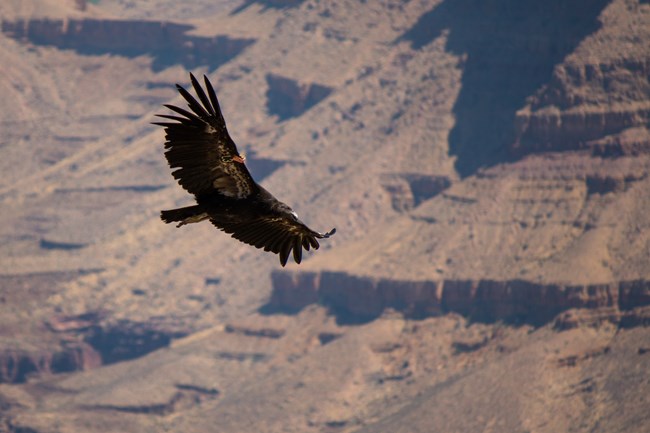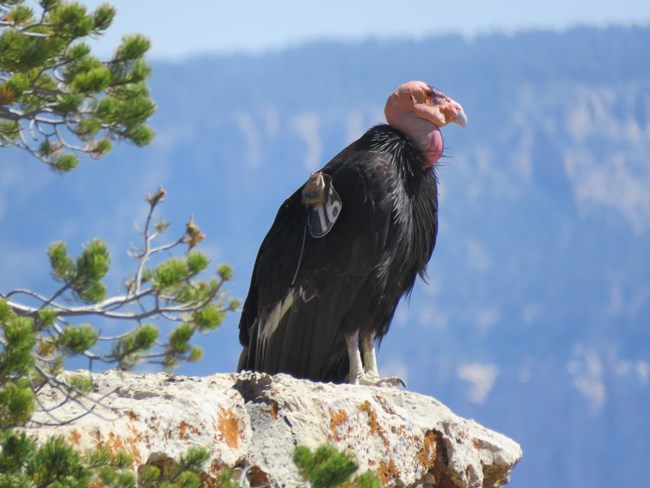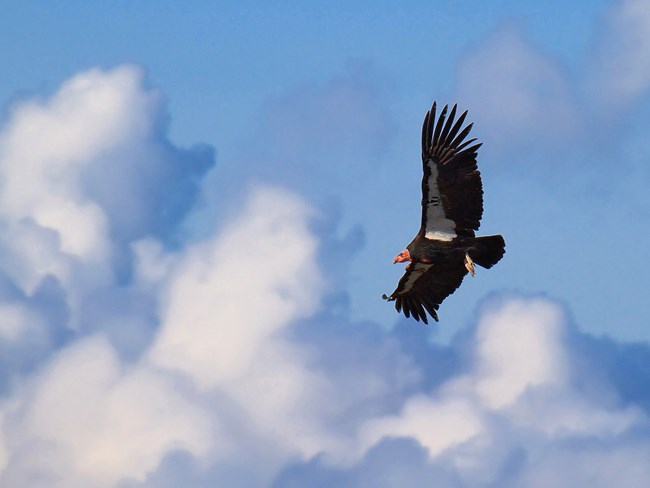The strange appearance and enormous size of condors inspire wonder in some, and fear in others. Legends about their natural history and the cause of their decline may not always be accurate. Listed below are some common myths about condors.

NPS/Gavin Emmons
MYTH: Condors can’t fly right after eating a lot because they are too heavy.
FACT: Condors have no trouble flying immediately after eating, even after they gorge themselves at carcasses. If there are no predators nearby, condors will often choose to perch at or near carcasses to continue feeding at a more leisurely pace, or to engage in social interactions with other condors. However, condors are fully capable of flying before, during, or after feeding.
MYTH: Condors are the only animals dying in large numbers from lead poisoning.
FACT: Lead is toxic and threatens most living things. Unfortunately, many other animals besides condors are getting sick and dying after eating spent lead ammunition. Scavengers are particularly susceptible to lead poisoning through ingestion of spent lead ammunition in carcasses, including bald eagles, golden eagles, coyotes, and other mammal and bird predators. The focus on recovering condors as an endangered species highlights the lethal effects of lead poisoning for condors in particular, but removing sources of lead poisoning from the environment is beneficial to all other animals in those habitats as well.

NPS/Eric Hope
MYTH: The real reason condors are dying isn’t lead poisoning - it’s antifreeze!
FACT: For over 30 years, necropsies performed on dead condors have demonstrated repeatedly and overwhelmingly that condors are mainly dying of lead poisoning from the ingestion of spent lead ammunition. Only one condor death has ever been linked conclusively to a bird drinking antifreeze, while hundreds of condors died due to lead poisoning. Antifreeze is a potential toxin, but is not a significant threat to condor populations.
MYTH: Lead occurs naturally, so we don’t really know if condors are getting lead poisoning mainly from lead bullets.
FACT: Thanks to decades of research, we do know conclusively that condors are primarily getting lead poisoning from eating spent lead ammunition. This is because lead used in different applications has different isotopic signatures. Basically these isotopic signatures are specific to different types of lead, so lead used in lead bullets has a different signature than lead used in paint, or lead that comes from the soil. Consistently, tests of lead poisoning in condors show isotopic signatures for lead bullets. In a limited number of cases, condors have eaten lead paint that has flaked off from historic structures, and blood lead tested from sampling these condors has shown isotopic signatures consistent with lead paint.
In a nutshell, the different isotopic signatures for lead have shown conclusively that condors are overwhelmingly getting lead poisoning from ingesting spent lead ammunition.

NPS/Brad Quicksall
MYTH: Condors are like huge birds of prey and have been known to kill livestock and fly away with them.
FACT: Condors are obligate scavengers, which means that they only eat dead animals. Although they look superficially similar to raptors with their hooked beaks and broad wings, condors are not birds of prey. Condor feet are flat, like big chicken feet, as opposed to the strong seizing talons of raptors like eagles and hawks. As a result, condors are not capable of killing livestock or flying away with even small animals. Condors will certainly eat livestock like calves or sheep that are already dead, but they do not kill live animals.
MYTH: Condors vomit as a defense mechanism to drive away predators.
FACT: Condors and other vultures will vomit or regurgitate freshly eaten material when they are nervous or agitated, but not chiefly as a defense mechanism. While nesting, condors will sometimes hiss or strike at predators to drive them away, but otherwise condors will usually respond to potential predators - such as coyotes or bobcats - by simply flying away from them.

NPS/Gavin Emmons
MYTH: Condors are going the way of the dodo - there’s nothing we can do to recover their populations and prevent them from going extinct.
FACT: Recovery of sustainable populations of California condors is absolutely achievable. Since condor populations reached a critical low point at less than 30 individuals in the mid 1980s, they have recovered to nearly 500 birds today, thanks to the efforts of biologists, researchers, land managers, and hunters. Condors need wide open landscapes and plenty of dead animals on the landscape to flourish, all of which are available in California and throughout the West. The main threat to California condors is lead poisoning from spent lead ammunition. If we can collectively commit to using alternatives to lead ammunition, condors can continue to increase their numbers and recover sustainable populations.
MYTH: Hunters are a threat to condors - we just need to get rid of hunting!
FACT: Hunters are not a threat to condors. In fact, hunters are critical to the recovery of condor populations. Hunters are important stewards of the natural world and have a long history of being strong supporters of conservation of wildlife and open landscapes. Many of the wildlife refuges we cherish today owe their existence to the tireless efforts of hunters in pushing for these areas to be protected. Many important conservation measures -- like removing lead shot from hunting of waterfowl -- were made possible thanks to hunters.
Hunters provide an important and stable source of food for condors and other scavengers. By using alternatives to lead ammunition like copper and steel, hunters can continue to serve as good stewards of the environment and can promote the recovery of sustainable populations of California condors.
Last updated: February 22, 2021
